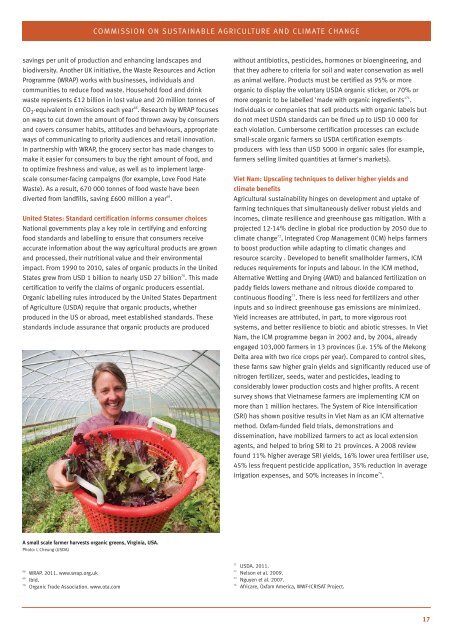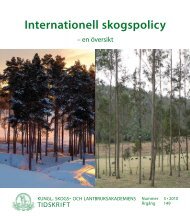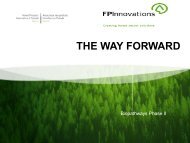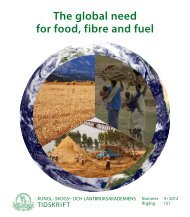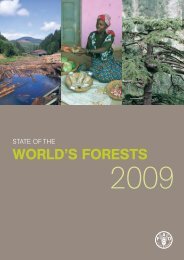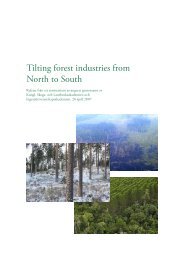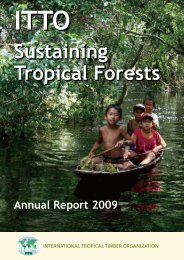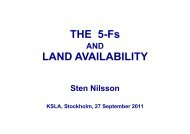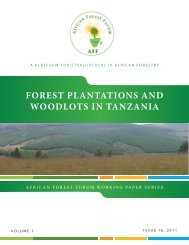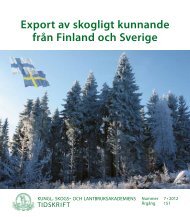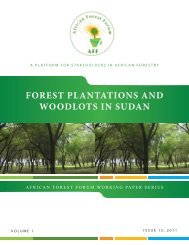Achieving food security in the face of climate change - CGSpace ...
Achieving food security in the face of climate change - CGSpace ...
Achieving food security in the face of climate change - CGSpace ...
Create successful ePaper yourself
Turn your PDF publications into a flip-book with our unique Google optimized e-Paper software.
COMMISSION ON SUSTAINABLE AGRICULTURE AND CLIMATE CHANGE<br />
sav<strong>in</strong>gs per unit <strong>of</strong> production and enhanc<strong>in</strong>g landscapes and<br />
biodiversity. Ano<strong>the</strong>r UK <strong>in</strong>itiative, <strong>the</strong> Waste Resources and Action<br />
Programme (WRAP) works with bus<strong>in</strong>esses, <strong>in</strong>dividuals and<br />
communities to reduce <strong>food</strong> waste. Household <strong>food</strong> and dr<strong>in</strong>k<br />
waste represents £12 billion <strong>in</strong> lost value and 20 million tonnes <strong>of</strong><br />
CO 2 -equivalent <strong>in</strong> emissions each year 68 . Research by WRAP focuses<br />
on ways to cut down <strong>the</strong> amount <strong>of</strong> <strong>food</strong> thrown away by consumers<br />
and covers consumer habits, attitudes and behaviours, appropriate<br />
ways <strong>of</strong> communicat<strong>in</strong>g to priority audiences and retail <strong>in</strong>novation.<br />
In partnership with WRAP, <strong>the</strong> grocery sector has made <strong>change</strong>s to<br />
make it easier for consumers to buy <strong>the</strong> right amount <strong>of</strong> <strong>food</strong>, and<br />
to optimize freshness and value, as well as to implement largescale<br />
consumer-fac<strong>in</strong>g campaigns (for example, Love Food Hate<br />
Waste). As a result, 670 000 tonnes <strong>of</strong> <strong>food</strong> waste have been<br />
diverted from landfills, sav<strong>in</strong>g £600 million a year 69 .<br />
United States: Standard certification <strong>in</strong>forms consumer choices<br />
National governments play a key role <strong>in</strong> certify<strong>in</strong>g and enforc<strong>in</strong>g<br />
<strong>food</strong> standards and labell<strong>in</strong>g to ensure that consumers receive<br />
accurate <strong>in</strong>formation about <strong>the</strong> way agricultural products are grown<br />
and processed, <strong>the</strong>ir nutritional value and <strong>the</strong>ir environmental<br />
impact. From 1990 to 2010, sales <strong>of</strong> organic products <strong>in</strong> <strong>the</strong> United<br />
States grew from USD 1 billion to nearly USD 27 billion 70 . This made<br />
certification to verify <strong>the</strong> claims <strong>of</strong> organic producers essential.<br />
Organic labell<strong>in</strong>g rules <strong>in</strong>troduced by <strong>the</strong> United States Department<br />
<strong>of</strong> Agriculture (USDA) require that organic products, whe<strong>the</strong>r<br />
produced <strong>in</strong> <strong>the</strong> US or abroad, meet established standards. These<br />
standards <strong>in</strong>clude assurance that organic products are produced<br />
without antibiotics, pesticides, hormones or bioeng<strong>in</strong>eer<strong>in</strong>g, and<br />
that <strong>the</strong>y adhere to criteria for soil and water conservation as well<br />
as animal welfare. Products must be certified as 95% or more<br />
organic to display <strong>the</strong> voluntary USDA organic sticker, or 70% or<br />
more organic to be labelled 'made with organic <strong>in</strong>gredients' 71 .<br />
Individuals or companies that sell products with organic labels but<br />
do not meet USDA standards can be f<strong>in</strong>ed up to USD 10 000 for<br />
each violation. Cumbersome certification processes can exclude<br />
small-scale organic farmers so USDA certification exempts<br />
producers with less than USD 5000 <strong>in</strong> organic sales (for example,<br />
farmers sell<strong>in</strong>g limited quantities at farmer's markets).<br />
Viet Nam: Upscal<strong>in</strong>g techniques to deliver higher yields and<br />
<strong>climate</strong> benefits<br />
Agricultural susta<strong>in</strong>ability h<strong>in</strong>ges on development and uptake <strong>of</strong><br />
farm<strong>in</strong>g techniques that simultaneously deliver robust yields and<br />
<strong>in</strong>comes, <strong>climate</strong> resilience and greenhouse gas mitigation. With a<br />
projected 12-14% decl<strong>in</strong>e <strong>in</strong> global rice production by 2050 due to<br />
<strong>climate</strong> <strong>change</strong> 72 , Integrated Crop Management (ICM) helps farmers<br />
to boost production while adapt<strong>in</strong>g to climatic <strong>change</strong>s and<br />
resource scarcity . Developed to benefit smallholder farmers, ICM<br />
reduces requirements for <strong>in</strong>puts and labour. In <strong>the</strong> ICM method,<br />
Alternative Wett<strong>in</strong>g and Dry<strong>in</strong>g (AWD) and balanced fertilization on<br />
paddy fields lowers methane and nitrous dioxide compared to<br />
cont<strong>in</strong>uous flood<strong>in</strong>g 73 . There is less need for fertilizers and o<strong>the</strong>r<br />
<strong>in</strong>puts and so <strong>in</strong>direct greenhouse gas emissions are m<strong>in</strong>imized.<br />
Yield <strong>in</strong>creases are attributed, <strong>in</strong> part, to more vigorous root<br />
systems, and better resilience to biotic and abiotic stresses. In Viet<br />
Nam, <strong>the</strong> ICM programme began <strong>in</strong> 2002 and, by 2004, already<br />
engaged 103,000 farmers <strong>in</strong> 13 prov<strong>in</strong>ces (i.e. 15% <strong>of</strong> <strong>the</strong> Mekong<br />
Delta area with two rice crops per year). Compared to control sites,<br />
<strong>the</strong>se farms saw higher gra<strong>in</strong> yields and significantly reduced use <strong>of</strong><br />
nitrogen fertilizer, seeds, water and pesticides, lead<strong>in</strong>g to<br />
considerably lower production costs and higher pr<strong>of</strong>its. A recent<br />
survey shows that Vietnamese farmers are implement<strong>in</strong>g ICM on<br />
more than 1 million hectares. The System <strong>of</strong> Rice Intensification<br />
(SRI) has shown positive results <strong>in</strong> Viet Nam as an ICM alternative<br />
method. Oxfam-funded field trials, demonstrations and<br />
dissem<strong>in</strong>ation, have mobilized farmers to act as local extension<br />
agents, and helped to br<strong>in</strong>g SRI to 21 prov<strong>in</strong>ces. A 2008 review<br />
found 11% higher average SRI yields, 16% lower urea fertiliser use,<br />
45% less frequent pesticide application, 35% reduction <strong>in</strong> average<br />
irrigation expenses, and 50% <strong>in</strong>creases <strong>in</strong> <strong>in</strong>come 74 .<br />
A small scale farmer harvests organic greens, Virg<strong>in</strong>ia, USA.<br />
Photo: L Cheung (USDA)<br />
68<br />
69<br />
70<br />
WRAP. 2011. www.wrap.org.uk<br />
Ibid.<br />
Organic Trade Association. www.ota.com<br />
71<br />
72<br />
73<br />
74<br />
USDA. 2011.<br />
Nelson et al. 2009.<br />
Nguyen et al. 2007.<br />
Africare, Oxfam America, WWF-ICRISAT Project.<br />
17


